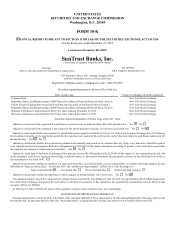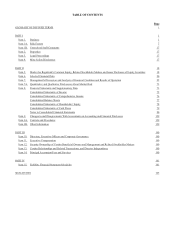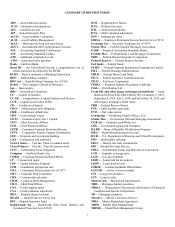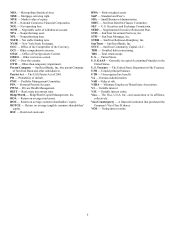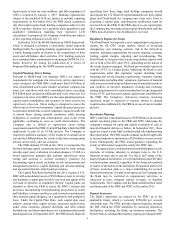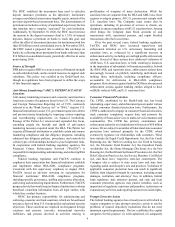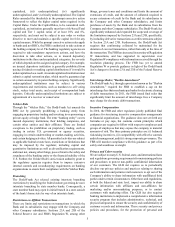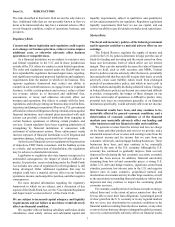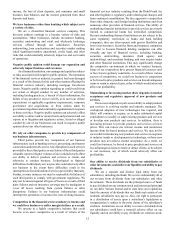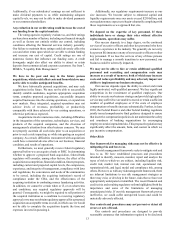SunTrust 2015 Annual Report Download - page 31
Download and view the complete annual report
Please find page 31 of the 2015 SunTrust annual report below. You can navigate through the pages in the report by either clicking on the pages listed below, or by using the keyword search tool below to find specific information within the annual report.3
liquid assets to total net cash outflows, and full compliance of
100% is required by January 1, 2017. Banking organizations
subject to the modified LCR are subject to monthly reporting
requirements. In November 2015, the FRB issued a proposed
rule that would require bank holding companies subject to the
LCR to publicly disclose on a quarterly basis quantitative and
qualitative information regarding their respective LCR
calculations. As proposed, the Company would become subject
to this reporting obligation in July, 2017.
In October 2014, the BCBS finalized an NSFR framework,
which is designed to promote a structurally sound long-term
funding profile by requiring banking organizations to maintain
a stable funding profile in relation to the composition of their
assets and off-balance sheet activities. U.S. banking agencies
have confirmed their commitment to adopting an NSFR for U.S.
banks; however, the timing for publication of a Notice of
Proposed Rulemaking for the NSFR remains unclear.
Capital Planning; Stress Testing
Pursuant to Dodd-Frank Act mandate, BHCs are subject to
requirements for company-run stress tests, and to supervisory
stress testing by the FRB. BHCs with more than $10 billion in
total consolidated assets must conduct an annual company-run
stress test, and those with total consolidated assets exceeding
$50 billion must conduct an additional mid-cycle stress test. For
company-run stress tests, BHCs use the same planning horizon,
capital action assumptions, and scenarios as those used in the
supervisory stress test. Stress testing is designed to assess the
effectiveness of covered companies’ capital adequacy processes
to determine whether the covered companies’ capital is sufficient
to absorb losses during stressful conditions, while meeting
obligations to creditors and counterparties, and, to the extent
applicable, continuing to serve as credit intermediaries. The
Company also is subject to supervisory stress testing
requirements under the FRB's Capital Plan Rule which the FRB
implements as part of its CCAR process. The Company is
required to publish a summary of the results of its annual stress
test and the FRB publishes the results of the stress testing under
adverse and severely adverse scenarios.
The FRB initiated CCAR in late 2010 to incorporate the
forward-looking capital assessment provided by stress testing
into the supervisory evaluation of capital adequacy. CCAR is a
broad supervisory program that includes supervisory stress
testing and assesses a covered company’s practices for
determining capital needs, including its risk measurement and
management practices, capital planning and decision-making,
and associated internal controls and governance.
The Capital Plan Rule finalized in late 2011, requires a U.S.
BHC with consolidated assets of $50 billion or more to develop
and maintain a capital plan which is reviewed and approved by
its board of directors or committee thereof. Capital plans are
intended to allow the FRB to assess the BHC’s systems and
processes incorporating forward-looking projections of assets
and liabilities, revenues and losses, and to monitor and maintain
their internal capital adequacy, on a quantitative and qualitative
basis. Under the Capital Plan Rule, each capital plan must
address, among other capital actions, projected capital ratios
under stress scenarios, planned dividends and other capital
distributions, and share repurchases over a minimum nine month
planning horizon. In September 2013, the FRB issued a final rule
specifying how these large bank holding companies should
incorporate the U.S. Basel III capital standards into their capital
plans and Dodd-Frank Act company-run stress tests. Prior to
executing a capital plan, non-objection notification must be
received from the FRB. If the FRB objects to our capital plan,
the Company may not make certain capital distributions until the
FRB's non-objection to the distribution is received.
Regulatory Regime for Swaps
The Dodd-Frank Act imposed a new comprehensive regulatory
regime for the OTC swaps market, aimed at increasing
transparency and reducing systemic risk in the derivatives
markets, including requirements for central clearing, exchange
trading, capital, margin, reporting, and recordkeeping. The
Dodd-Frank Act requires that certain swap dealers register with
one or both of the SEC and CFTC, depending on the nature of
the swaps business engaged. The Bank provisionally registered
with the CFTC as a swaps dealer, subjecting the Bank to new
requirements under this regulatory regime including trade
reporting and record keeping requirements, business conduct
requirements (including daily valuations, disclosure of material
risks associated with swaps and disclosure of material incentives
and conflicts of interest), mandatory clearing and exchange
trading requirements for certain standardized swaps designated
by the CFTC, and increased capital requirements established by
the FRB. The Company’s derivatives business involving
uncleared swaps is expected to become subject to margin
requirements established by the FRB in excess of current market
practice.
Resolution Planning
BHCs with total consolidated assets of $50 billion or more must
submit resolution plans to the FRB and FDIC addressing the
company's strategy for rapid and orderly resolution in case of
material financial distress or failure. In September 2011, these
agencies issued a joint final resolution plan rule implementing
this requirement. The FDIC issued a separate such rule applicable
to insured depository institutions of $50 billion or more in total
assets. Subsequently, the FDIC issued guidance expanding the
extent of information required to satisfy the FDIC rule.
The agencies have widely promoted resolution plans as core
elements of reforms intended to mitigate risks to the U.S.
financial system, and to end the “too big to fail” status of the
largest financial institutions. Covered institutions must file their
resolution plans annually, regardless of the financial condition
or nature of operations of the institution. Preparation and review
of these resolution plans is a major undertaking for covered
financial institutions. If a plan is not approved, the Company and
the Bank may be restricted in expansionary activities, or
subjected to more stringent capital, leverage, or liquidity
requirements. The Company and the Bank submitted their latest
resolution plan to the FRB and FDIC in December 2015.
Deposit Insurance
The Bank’s depositors are insured by the FDIC up to the
applicable limits, which is currently $250,000 per account
ownership type. The FDIC provides deposit insurance through
the DIF, which the FDIC maintains by assessing depository
institutions, including the Bank, an insurance premium. The
Dodd-Frank Act changed the statutory regime governing the DIF.






